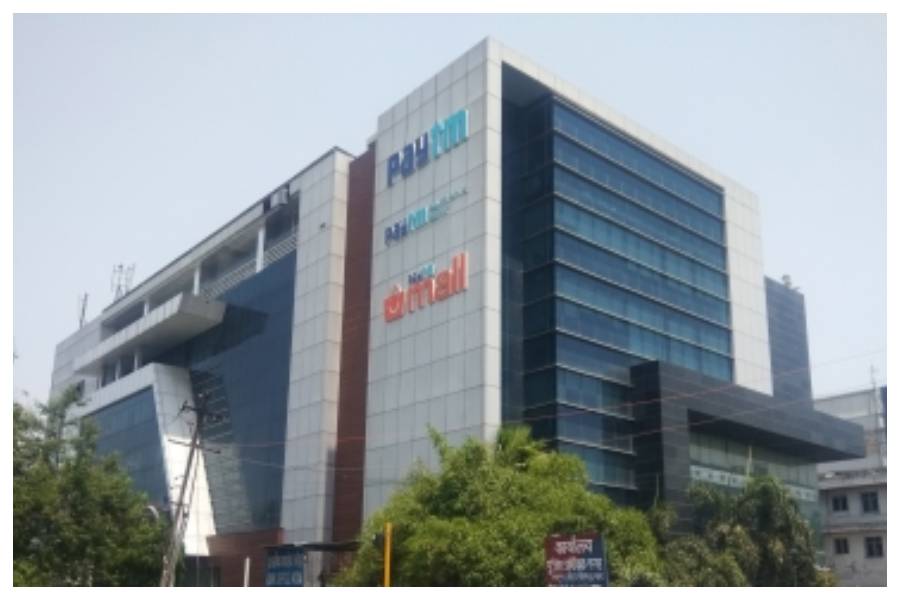Business
Paytm FY22 results: Revenue jumps 77% to Rs 4,974 cr, losses reduce 8% to Rs 1,518 cr

One97 Communications Limited (OCL) that owns the brand Paytm, Indias leading mobile payments and financial services company, announced its quarter-ending March 2022 and full financial year FY22 results. The company saw its revenue jump by 77 per cent in FY22 to Rs 4,974 crore from Rs 2,802 crore the previous year.
In Q4 alone, the company’s revenue grew 89% on a year-on-year basis to Rs 1,541 crore, while EBITDA (before ESOPs) for the quarter improved 12 per cent year-on-year.
The growth in revenue was led by the increase in consumer and merchant payments and disbursements of loans through its partners on Paytm.
The company’s EBITDA loss (before ESOP) for FY22 saw an improvement of 8 per cent year-on-year to Rs 1,518 crore from Rs 1,655 crore the previous year. In addition, the company had Rs 809 crore of non-cash ESOP expenses.
Paytm has reduced EBITDA (before ESOP cost) loss despite making investments in user growth, merchant device deployment and technology. The company’s cost structures in Q4 FY 2022 are largely sufficient to support its growth plans in FY 2023. As a result, the company believes it will show accelerated reduction in EBITDA losses and is well on track to achieve profitability (before ESOP) by September 2023 quarter.
Paytm has a strong two-sided ecosystem of consumers and merchants, where it is seeing the monetization strategy kick in to yield results. On the consumer payments side, the company is recording increasing usage of the Paytm app and Paytm Payment instruments. On the merchant payments side, the company serves the entire base of merchants through (i) QR for payments (typically free), (ii) soundboxes (which generate subscription revenues), (iii) card machines (which generate subscription and MDR revenues), and (iv) Payment Gateway for online merchants (which generates MDR revenues and platform fees). Leveraging this distribution and rich insights, Paytm offers financial products to its consumers and merchants, in partnership with financial institutions.
Increased consumer engagement and merchant base leads to higher revenue from Payment services. The company has recorded a jump in its average monthly transacting users in FY22 to 60.8 million, the average for the last quarter further increased to 70.9 million. Paytm’s merchant base has also grown to now have 26.7 million merchant partners, with 2.9 million devices deployed as of FY22.
The increased consumer engagement and merchant base has also led to increased revenue from Payment Services (both to consumers and merchants). Paytm’s Revenue from Payment Services to Consumers was up 58 per cent to Rs 1,529 crore in FY 2022 from Rs 969 Cr for the FY 2021. For the full year, Revenue from Payment Services to Merchants was up 87 per cent to Rs 1,892 crore in FY 2022 from Rs 1,012 crore for FY 2021.
One of the highlights of Q4FY22 and FY22 has been the rapid scale-up of Paytm’s loan disbursement business, where it offers Paytm Postpaid (Buy Now, Pay Later), personal loans and merchant loans. In April 2022, the company reached an annualised run rate of approximately Rs 20,000 crore of disbursement through its platform.
For the full year, the number of loans disbursed through the Paytm platform has grown 478 per cent year-on-year to 15.2 million in FY 2022 from 2.6 million in FY 2021. The value of loans disbursed has grown 441 per cent year-on-year from Rs 1,409 crore in FY 2021 to Rs 7,623 crore in FY 2022.
The number of Postpaid Loans disbursed grew 373 per cent year-on-year in Q4 FY 2022, while the value of Postpaid Loans grew 425 per cent year-on-year, thus highlighting increased usage by customers.
Personal Loans disbursed through partners on Paytm grew 948 per cent year-on-year in Q4 FY 2022, while the value of Personal Loans grew 1,082 per cent year-on-year. The number of Merchant Loans disbursed grew 123 per cent year-on-year in Q4 FY 2022, while the value of Merchant Loans grew 178 per cent year-on-year. The average ticket size has also increased in FY22, with personal loans ranging from Rs 85,000 to Rs 95,000 and merchant loans ranging from Rs 1,30,000 to Rs 1,50,000.
Business
Sensex, Nifty turn positive after early losses ahead of key Q2 GDP data release

Mumbai, Nov 28: Benchmark indices Sensex and Nifty turned positive on Friday after recovering from early losses, supported by buying on dips ahead of the key Q2FY26 GDP data, which will be released later today.
The Sensex rose 101 points to 85,821, up 0.12 per cent, while the Nifty inched up 35 points to 26,251, a gain of 0.14 per cent.
“The Nifty seems likely to stay within a defined range, with near-term resistance in the 26,300–26,350 area and support near 26,050–26,100; dips toward this support zone may offer fresh buying opportunities,” analysts said.
Strong buying in heavyweight stocks such as Mahindra & Mahindra, Tech Mahindra, Titan, SBI, Maruti Suzuki, Hindustan Unilever, Tata Motors PV, and Sun Pharma helped the market erase its morning losses.
However, the overall upside was limited due to weakness in Asian Paints, Power Grid, Adani Ports, Axis Bank, Infosys, Eternal, HDFC Bank, and Tata Steel.
The market action comes a day after both indices hit fresh all-time highs in intra-day trade on Thursday, with the Sensex crossing 86,000 for the first time and the Nifty moving past 26,300.
In the broader market, sentiment remained weak as the Nifty MidCap index slipped 0.16 per cent, while the Nifty SmallCap index fell 0.36 per cent.
Among sectors, Nifty Auto led the gains with a 0.5 per cent rise, followed by Nifty FMCG up 0.16 per cent and Nifty Metal up 0.13 per cent. On the other hand, the Nifty Private Bank index declined 0.15 per cent, weighing slightly on overall market momentum.
Business
Job postings in India stay above pre-Covid pandemic levels: Report

New Delhi, Nov 27: Formal job creation in India softened in the month of October but despite this, job postings remained above the pre-Covid pandemic level, a report said on Thursday.
“Amid slowdown, Indian job postings are still 60 per cent above pre-pandemic levels, but have fallen 25 per cent since their peak in January 2023,” Indeed, a leading hiring platform, said in its report.
Over the past three months, job postings declined in almost three-quarters of occupations. Yet in a softening job market, there will still be some strong performers, and the past three months have been no exception, said the report.
Job postings in cleaning and sanitation rose around 20 per cent over the past three months, ahead of community and social service (17.4 per cent), dental (13.1 per cent), nursing (11.2 per cent) and food preparation and service (10.3 per cent).
Another positive was the posting for human resources, which climbed 2.3 per cent.
However, these gains were more than offset by weakness in banking and finance, where postings fell 25.6 per cent, along with legal (-22.4 per cent), retail (-16.7 per cent) and loading and stocking (-15 per cent), the report noted.
Every month, the Indian workforce gradually transitions towards more formal work arrangements. As the nation transitions, job creation in the formal sector is expected to outpace overall employment growth nationwide, said Callam Pickering, Indeed’s APAC Senior Economist.
“This transition is also why job postings in India have been stronger than in other Indeed markets, both during the post-pandemic job boom and the subsequent slowdown,” he added.
Meanwhile, during the month, 9.1 per cent of Indian job postings explicitly mentioned phrases such as ‘work from home’ or ‘work remotely’ in their job descriptions. That’s up from 7.6 per cent a year ago.
Remote opportunities are most common in IT infrastructure, operations and support at 18.2 per cent of postings in the October quarter 2025, ahead of community & social service (15.1 per cent) and industrial engineering (14 per cent).
Business
From Kachchhi Kharek to Kesar Mango: Over 10 treasures of Kutch and Saurashtra earn GI tag

Gandhinagar, Nov 27: Prime Minister Narendra Modi has consistently championed India’s indigenous and heritage products, placing local strength at the heart of national growth. His call for Vocal for Local and Aatmanirbhar Bharat has given visibility to artisans and farmers across the country.
In line with this vision, the Prime Minister has also actively promoted Geographical Indication (GI) products, highlighting them in his radio address Mann Ki Baat and personally felicitating artisans who preserve traditional crafts.
Union Commerce and Industry Minister Piyush Goyal has set an ambitious goal of reaching 10,000 GI-tagged products across India by 2030 under the vision of “Vikas Bhi, Virasat Bhi.”
Gujarat has emerged as a strong contributor to this national mission by promoting its rich artisanal heritage, from Kutch’s celebrated crafts to Saurashtra’s premium agricultural produce on global platforms.
GI tagging reinforces the state’s commitment to “Viksit Gujarat to Viksit Bharat,” transforming local skills into global competitiveness. Kutch and Saurashtra together have secured GI recognition for over ten iconic products, including Ajrakh block printing, Bandhani tie-dye, Rogan art, Kutch shawls, the famed Kachchhi Kharek, and the globally loved Gir Kesar mango.
The upcoming Vibrant Gujarat Regional Conference (VGRC) in Rajkot will spotlight the region’s craft excellence and export capacity, offering artisans a robust platform to scale their businesses.
Renowned for its blend of tradition and artistry, Kutch boasts GI-tagged crafts such as embroidery, Ajrakh printing, Bandhani, Rogan painting and the Kutch shawl. In the agricultural category, Kachchhi Kharek — a celebrated variety of date known for its rich flavour and nutritional value has also earned GI status.
Saurashtra’s signature products include Gir Kesar mango, often hailed as the “Queen of Mangoes,” the famed Jamnagari Bandhani, and the exquisite Rajkot Patola silk weaving tradition, cherished by Bollywood celebrities.
Surendranagar’s Tangaliya shawl, with its intricate weaving technique, has also built a loyal international following. The upcoming VGRC for Saurashtra and Kutch aims to accelerate the region’s artisan economy.
The two-day conference will bring together entrepreneurs, artisans, interior designers and product designers, creating avenues of collaboration with the Government e-Marketplace, private enterprises, investors and leading e-commerce platforms. The event promises to enhance innovation, expand market access and drive sustainable growth for traditional craft clusters.
-

 Crime3 years ago
Crime3 years agoClass 10 student jumps to death in Jaipur
-

 Maharashtra1 year ago
Maharashtra1 year agoMumbai Local Train Update: Central Railway’s New Timetable Comes Into Effect; Check Full List Of Revised Timings & Stations
-

 Maharashtra1 year ago
Maharashtra1 year agoMumbai To Go Toll-Free Tonight! Maharashtra Govt Announces Complete Toll Waiver For Light Motor Vehicles At All 5 Entry Points Of City
-

 Maharashtra1 year ago
Maharashtra1 year agoFalse photo of Imtiaz Jaleel’s rally, exposing the fooling conspiracy
-

 National News1 year ago
National News1 year agoMinistry of Railways rolls out Special Drive 4.0 with focus on digitisation, cleanliness, inclusiveness and grievance redressal
-

 Maharashtra1 year ago
Maharashtra1 year agoMaharashtra Elections 2024: Mumbai Metro & BEST Services Extended Till Midnight On Voting Day
-

 National News1 year ago
National News1 year agoJ&K: 4 Jawans Killed, 28 Injured After Bus Carrying BSF Personnel For Poll Duty Falls Into Gorge In Budgam; Terrifying Visuals Surface
-

 Crime1 year ago
Crime1 year agoBaba Siddique Murder: Mumbai Police Unable To Get Lawrence Bishnoi Custody Due To Home Ministry Order, Says Report


















